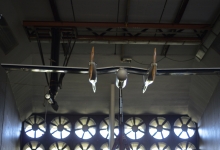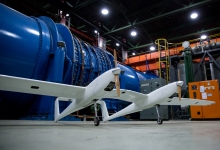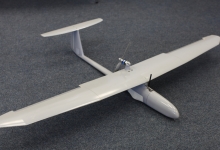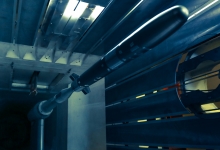Aeronautics innovations
The CSIR is home to leading aeronautical research and development. Engineers and scientists, access to specialist infrastructure and equipment, as well as global technology collaborations contribute to the CSIR’s status as a world-class aeronautics capability.
Unmanned aircraft systems
The CSIR’s research and development portfolio in unmanned aircraft systems (UAS) has grown considerably with increasing demand for the use of its research platforms as well as its aerodynamic design and optimisation capability. The CSIR houses a UAS laboratory that incorporates high-fidelity flight simulators with aircraft sub-system hardware-in-the-loop, such as autopilots and control surface servo actuators.
The CSIR leverages its access to a wide range of technical disciplines, such as aeronautics, radar, optronics, propulsion and structures, to develop credible models of alternative designs. The characteristics, such as flight performance, radar cross-section and infrared signatures of these alternative designs are then determined. These designs are tested in a realistic mission scenario(s), incorporating integrated air defences. The goal of the trade study is to identify the Pareto front of robust, high-performing design alternatives that serve as the starting point for further development.
The mission simulation model incorporates a detailed terrain model, aircraft, radars, missiles, guns and integrated air defence command and control. A number of well-known air defence systems are modelled and additional models are created using the object-orientated design of the code. The impact of variable parameters is examined using Monte Carlo analysis, facilitated by the model’s exceptionally fast C++ source code.
The robustness of preferred design alternatives is tested using sensitivity analyses before the final results are selected. This gives confidence that the promised performance is likely to be retained despite the changes that are inevitable during subsequent product development.
Indiza
Indiza is a small, rugged and highly efficient hand-launched UAS. The fuselage is fitted with a modular payload system which can support a number of interchangeable cameras or other systems. The airframe contains the GPS based autopilot, radio modem and video transmitter. The ground-based equipment currently consists of a laptop-based mission planner and tracking antenna system for the video and data links. There is an optional radio control transmitter and airborne receiver for man-in-the-loop control of both the airframe and the camera system. The system has been used to provide photographic and video information in the border safeguarding environments. The airframe can accommodate a number of generic camera pods. These interchangeable pods consist of three different types of camera systems, including:
- A pan, tilt and stow twin-camera system;
- A stowable high-definition wide-angle video camera; and
- A 3G cellphone-based camera.
Long-endurance modular UAV (LEMU)
The Long-endurance modular UAV (LEMU) is a research platform, designed to provide the capability for validating novel technology components and/or basic sub-systems by integration and demonstration in a relevant flight environment. A central hard point on the wing provides the capability to mount custom-sized payload pods. All major aerodynamic control surfaces (ailerons, elevator, rudders and flaps) are replicated, introducing redundancy into the airframe. A horizontal stabiliser joins the two vertical fins. Two variants of LEMU are currently in development at the CSIR: LEMU Internal Combustion is powered by two fuel- injected internal combustion engines and provide up to eight hours of endurance. LEMU Electric is powered by two brushless electric motors and providing up to one-hour endurance.
Store integration
The CSIR has the capability to integrate the client’s store with any aircraft. This includes functional integration as well as compatibility evaluation for airworthiness certification. A systems engineering approach is followed that complies with military and airworthiness standards. The CSIR has particular expertise in evaluating the aero/mechanical impacts of integrating stores with the aircraft. This work is done in compliance with MIL-HDBK-1763 and covers the following aspects; aeroelasticity (flutter); store separation behaviour; loads on aircraft during carriage and impact on aircraft performance and handling characteristics.
The CSIR has developed store separation analysis tools in-house and leads the field in South Africa. These tools include:
- ARUV panel code;
- Computational fluid dynamics codes;
- The medium-speed wind tunnel fitted with a captive trajectory system; and
- The analyse ejection code system.
Capabilities
Mission simulation framework
The mission simulation framework (MSF) is a scenario simulation tool capable of simulating the interactions between a large numbers of land- or air- based entities. It runs faster than real-time with optional visualisation that can be run at a large range of speeds. Its primary purpose is to provide insight into the outcome of various engagement scenarios in particular air-to-air and air-to-ground missions. Two types of models are currently utilised. Generic models exist of aircraft, missiles, radars, guns, launchers, fire control systems and data links. Specific system models such as those of the Pantsir-S1, Buk-M2, SA-6, SA-13, Shilka anti-aircraft gun system, Snow Drift target acquisition radar, Straight Flush radar and many more have been created from open information sources, through consultation with experts in the relevant fields and physics modelling. Terrain modelling is included to model line-of-sight link limitations for scenarios that have terrain- based sensors.
Decoy rockets
Ballistic rockets fired as decoys are used to protect high-value vessels against the threat of anti-craft radar missiles. The CSIR undertakes concept development, design, prototyping and testing – up to the point where actual, measured performance during a flight test can be correlated to theoretical intentions.
Aircraft design and evaluation capabilities
The CSIR has developed a number of aircrafts, including the SARA series of gyrocopters, the all-carbon fibre military turboprop trainer ACE and the Hummingbird - a very low speed observation light aircraft. The CSIR undertakes conceptual design, detailed design, and aerodynamic characterisation through wind-tunnel testing or through computational methods. Various other scientific experiment techniques are used, as well as high-fidelity man-in-the-loop simulations of both fixed and rotary winged aircraft for validation of flight data and the evaluation and optimisation of handling qualities.





